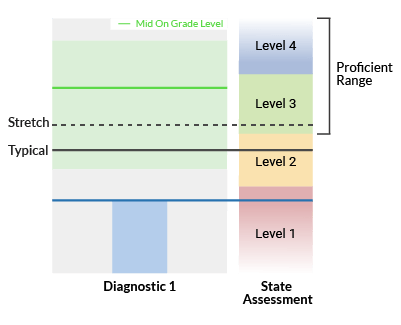
How Do We Know Our Students Are Learning? And If Not, What Can We Do about It?
2-min. read
3-min. read
By: Ken Tam

We’ve all seen the headlines about the challenging state of student learning, but I want to shift the conversation to what we can do to recover. Rather than focus on unfinished learning, let’s think about a way to determine if we are growing our students at a rate that allows them to be on track to proficiency or advance proficiency, while also ensuring they don’t fall even further behind. Today, accelerating student growth has never been more important.
When we think about recovery, it’s really about growth, but our historical focus on typical or a year’s worth of growth may not be enough for students who have fallen below grade level. We need to establish Stretch Growth goals instead—the amount of growth a student needs to get on the path to grade-level proficiency.

Stretch Growth goals can be determined using the growth trajectory of actual students who were behind but eventually achieved grade-level proficiency. Key characteristics of these goals should be:
Our research shows that out of more than 200,000 students who met their Stretch Growth goals in mathematics and reading for two consecutive years, 79 percent of them were proficient by the end of the second year, with a placement of Mid On Grade Level or higher. Ninety-four percent ended the second year able to access grade-level instruction (i.e., Early On Grade Level or higher), demonstrating the positive cumulative impact of implementing Stretch Growth goals.
To support Stretch Growth attainment, diagnostic data can help you understand your students’ exact needs. What are their next steps for instruction to put them on a path to proficiency? What can they do so you can celebrate their progress and foster an asset-based mindset?
Believe in them. All learners can grow and achieve grade-level expectations if they have the right support. Given the state of unfinished learning today, it may seem counterintuitive to push your students who need support out of their comfort zones, but that’s exactly what they need. If they know you believe in them, they will believe in themselves.
According to The New Teacher Project’s The Opportunity Myth, teacher expectations for student success against grade-level standards demonstrated the strongest relationship to student growth, underscoring how important your role as a teacher is. When students know you care, it impacts what they can achieve. Rita Pierson’s famous words—“Every child deserves a champion . . . an adult who will never give up on them”—have never been more relevant.
Teach them what they need to know to be successful with their grade-level instruction. Believing in your students is only the first step. You also need to teach them the critical foundational or prerequisite skills that allow them to understand grade-level concepts. If you try to teach them everything they’ve missed and remediate, it’s overwhelming, and they will never be able to catch up. But if you scaffold your teaching by providing just-in-time instructions on only what they need to know based on their unfinished learning in prior grade-level topics, you will be able to accelerate learning and instill a sense of confidence in them.
Determining which skills are critical for getting your students to grade level doesn’t have to mean searching through all your instructional content to find just the right worksheet. Your time is better spent teaching. There are tools out there that can automatically curate the critical content for you to address each of your students’ specific needs, allowing you to provide grade-level content at the same time.
With a detailed picture of each of your students, prerequisite content to address the skills they need to master, and high expectations, they’ll be well on their way.

2-min. read

2-min. read

2-min. read